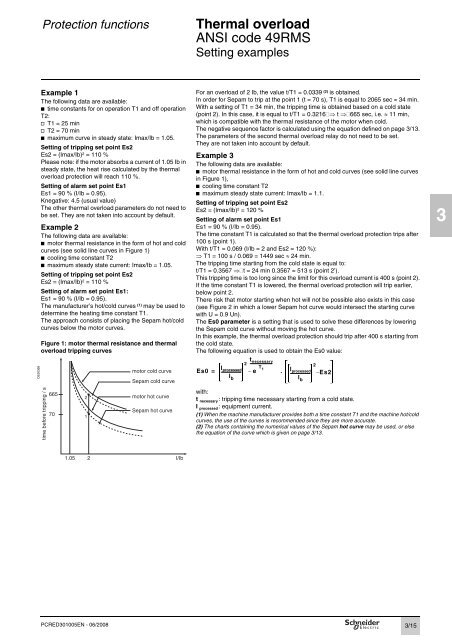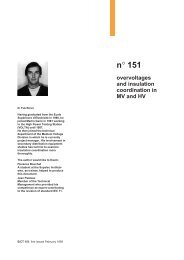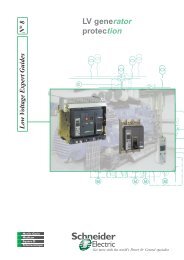sepam 20 user manual - Schneider Electric
sepam 20 user manual - Schneider Electric
sepam 20 user manual - Schneider Electric
You also want an ePaper? Increase the reach of your titles
YUMPU automatically turns print PDFs into web optimized ePapers that Google loves.
Protection functions Thermal overload<br />
ANSI code 49RMS<br />
Setting examples<br />
Example 1<br />
The following data are available:<br />
b time constants for on operation T1 and off operation<br />
T2:<br />
v T1 = 25 min<br />
v T2 = 70 min<br />
b maximum curve in steady state: Imax/Ib = 1.05.<br />
Setting of tripping set point Es2<br />
Es2 = (Imax/Ib) 2 = 110 %<br />
Please note: if the motor absorbs a current of 1.05 Ib in<br />
steady state, the heat rise calculated by the thermal<br />
overload protection will reach 110 %.<br />
Setting of alarm set point Es1<br />
Es1 = 90 % (I/Ib = 0.95).<br />
Knegative: 4.5 (usual value)<br />
The other thermal overload parameters do not need to<br />
be set. They are not taken into account by default.<br />
Example 2<br />
The following data are available:<br />
b motor thermal resistance in the form of hot and cold<br />
curves (see solid line curves in Figure 1)<br />
b cooling time constant T2<br />
b maximum steady state current: Imax/Ib = 1.05.<br />
Setting of tripping set point Es2<br />
Es2 = (Imax/Ib) 2 = 110 %<br />
Setting of alarm set point Es1:<br />
Es1 = 90 % (I/Ib = 0.95).<br />
The manufacturer’s hot/cold curves (1) may be used to<br />
determine the heating time constant T1.<br />
The approach consists of placing the Sepam hot/cold<br />
curves below the motor curves.<br />
DE50368<br />
Figure 1: motor thermal resistance and thermal<br />
overload tripping curves<br />
time before tripping / s<br />
665<br />
70<br />
PCRED301005EN - 06/<strong>20</strong>08<br />
2<br />
1<br />
1.05 2<br />
motor cold curve<br />
Sepam cold curve<br />
motor hot curve<br />
Sepam hot curve<br />
I/Ib<br />
For an overload of 2 Ib, the value t/T1 = 0.0339 (2) is obtained.<br />
In order for Sepam to trip at the point 1 (t = 70 s), T1 is equal to <strong>20</strong>65 sec ≈ 34 min.<br />
With a setting of T1 = 34 min, the tripping time is obtained based on a cold state<br />
(point 2). In this case, it is equal to t/T1 = 0.3216 ⇒ t ⇒ 665 sec, i.e. ≈ 11 min,<br />
which is compatible with the thermal resistance of the motor when cold.<br />
The negative sequence factor is calculated using the equation defined on page 3/13.<br />
The parameters of the second thermal overload relay do not need to be set.<br />
They are not taken into account by default.<br />
Example 3<br />
The following data are available:<br />
b motor thermal resistance in the form of hot and cold curves (see solid line curves<br />
in Figure 1),<br />
b cooling time constant T2<br />
b maximum steady state current: Imax/Ib = 1.1.<br />
Setting of tripping set point Es2<br />
Es2 = (Imax/Ib) 2 = 1<strong>20</strong> %<br />
Setting of alarm set point Es1<br />
Es1 = 90 % (I/Ib = 0.95).<br />
The time constant T1 is calculated so that the thermal overload protection trips after<br />
100 s (point 1).<br />
With t/T1 = 0.069 (I/Ib = 2 and Es2 = 1<strong>20</strong> %):<br />
⇒ T1 = 100 s / 0.069 = 1449 sec ≈ 24 min.<br />
The tripping time starting from the cold state is equal to:<br />
t/T1 = 0.3567 ⇒ t = 24 min 0.3567 = 513 s (point 2’).<br />
This tripping time is too long since the limit for this overload current is 400 s (point 2).<br />
If the time constant T1 is lowered, the thermal overload protection will trip earlier,<br />
below point 2.<br />
There risk that motor starting when hot will not be possible also exists in this case<br />
(see Figure 2 in which a lower Sepam hot curve would intersect the starting curve<br />
with U = 0.9 Un).<br />
The Es0 parameter is a setting that is used to solve these differences by lowering<br />
the Sepam cold curve without moving the hot curve.<br />
In this example, the thermal overload protection should trip after 400 s starting from<br />
the cold state.<br />
The following equation is used to obtain the Es0 value:<br />
Es0 =<br />
lprocessed ------------------lb<br />
tnecessary 2 ----------------------<br />
T1 – e<br />
. lprocessed ------------------lb<br />
2<br />
– Es2<br />
with:<br />
t necessary : tripping time necessary starting from a cold state.<br />
I processed : equipment current.<br />
(1) When the machine manufacturer provides both a time constant T1 and the machine hot/cold<br />
curves, the use of the curves is recommended since they are more accurate.<br />
(2) The charts containing the numerical values of the Sepam hot curve may be used, or else<br />
the equation of the curve which is given on page 3/13.<br />
3/15<br />
3

















